2007 CHEVROLET AVEO brake
[x] Cancel search: brakePage 392 of 436
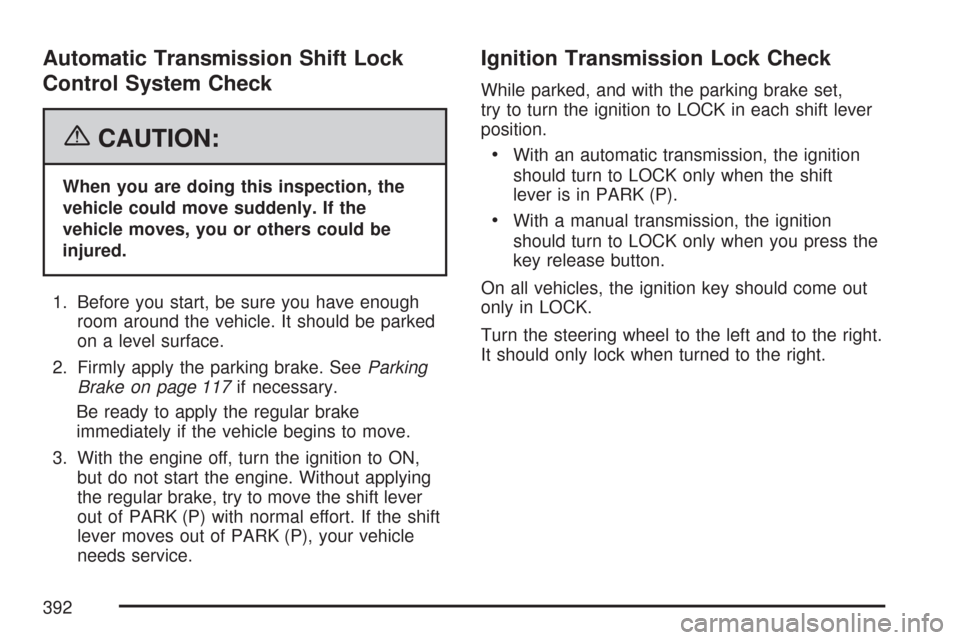
Automatic Transmission Shift Lock
Control System Check
{CAUTION:
When you are doing this inspection, the
vehicle could move suddenly. If the
vehicle moves, you or others could be
injured.
1. Before you start, be sure you have enough
room around the vehicle. It should be parked
on a level surface.
2. Firmly apply the parking brake. SeeParking
Brake on page 117if necessary.
Be ready to apply the regular brake
immediately if the vehicle begins to move.
3. With the engine off, turn the ignition to ON,
but do not start the engine. Without applying
the regular brake, try to move the shift lever
out of PARK (P) with normal effort. If the shift
lever moves out of PARK (P), your vehicle
needs service.
Ignition Transmission Lock Check
While parked, and with the parking brake set,
try to turn the ignition to LOCK in each shift lever
position.
•With an automatic transmission, the ignition
should turn to LOCK only when the shift
lever is in PARK (P).
•With a manual transmission, the ignition
should turn to LOCK only when you press the
key release button.
On all vehicles, the ignition key should come out
only in LOCK.
Turn the steering wheel to the left and to the right.
It should only lock when turned to the right.
392
Page 393 of 436
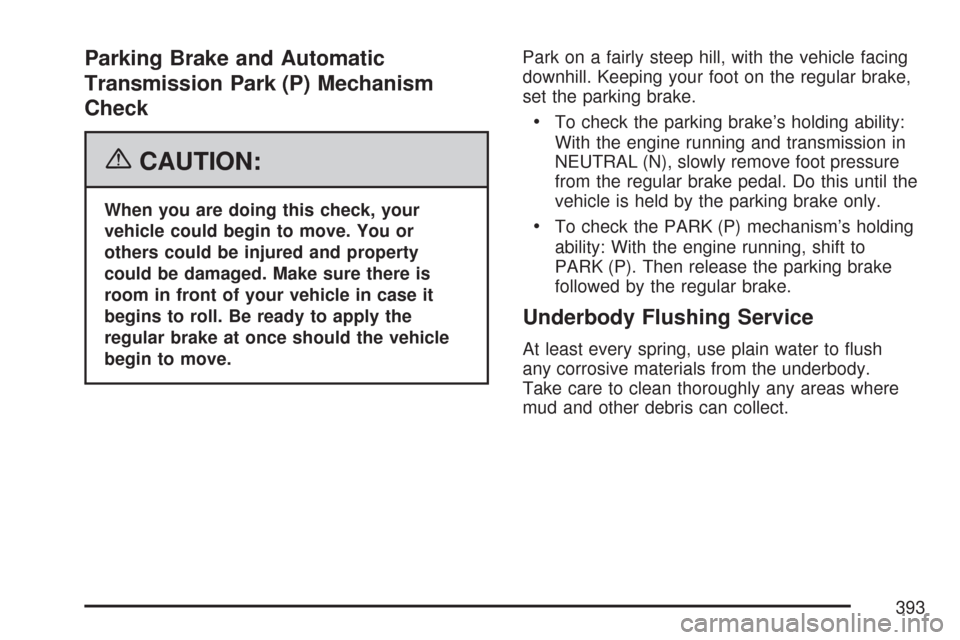
Parking Brake and Automatic
Transmission Park (P) Mechanism
Check
{CAUTION:
When you are doing this check, your
vehicle could begin to move. You or
others could be injured and property
could be damaged. Make sure there is
room in front of your vehicle in case it
begins to roll. Be ready to apply the
regular brake at once should the vehicle
begin to move.Park on a fairly steep hill, with the vehicle facing
downhill. Keeping your foot on the regular brake,
set the parking brake.
•To check the parking brake’s holding ability:
With the engine running and transmission in
NEUTRAL (N), slowly remove foot pressure
from the regular brake pedal. Do this until the
vehicle is held by the parking brake only.
•To check the PARK (P) mechanism’s holding
ability: With the engine running, shift to
PARK (P). Then release the parking brake
followed by the regular brake.
Underbody Flushing Service
At least every spring, use plain water to flush
any corrosive materials from the underbody.
Take care to clean thoroughly any areas where
mud and other debris can collect.
393
Page 395 of 436
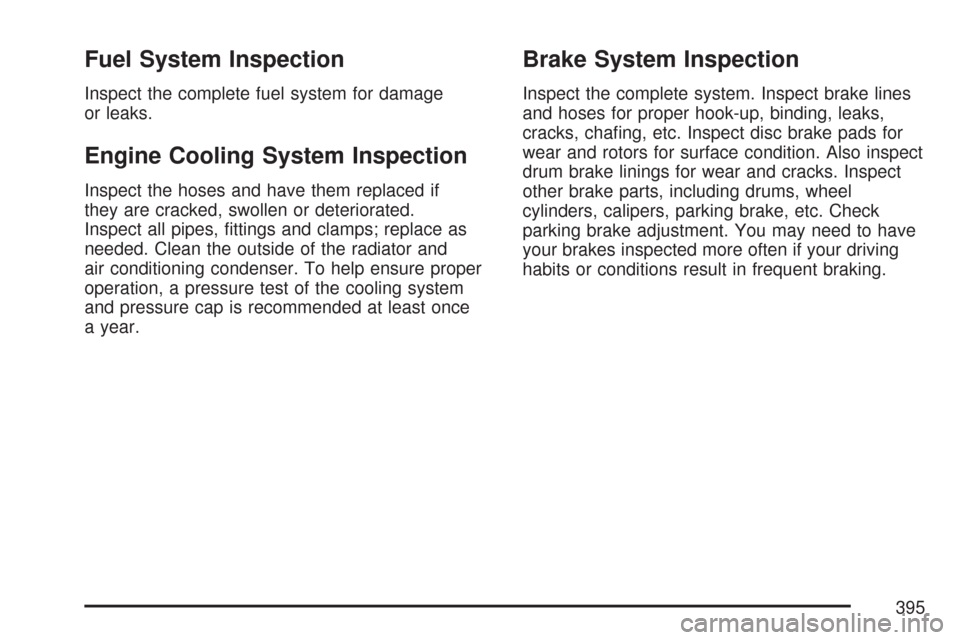
Fuel System Inspection
Inspect the complete fuel system for damage
or leaks.
Engine Cooling System Inspection
Inspect the hoses and have them replaced if
they are cracked, swollen or deteriorated.
Inspect all pipes, fittings and clamps; replace as
needed. Clean the outside of the radiator and
air conditioning condenser. To help ensure proper
operation, a pressure test of the cooling system
and pressure cap is recommended at least once
a year.
Brake System Inspection
Inspect the complete system. Inspect brake lines
and hoses for proper hook-up, binding, leaks,
cracks, chafing, etc. Inspect disc brake pads for
wear and rotors for surface condition. Also inspect
drum brake linings for wear and cracks. Inspect
other brake parts, including drums, wheel
cylinders, calipers, parking brake, etc. Check
parking brake adjustment. You may need to have
your brakes inspected more often if your driving
habits or conditions result in frequent braking.
395
Page 396 of 436
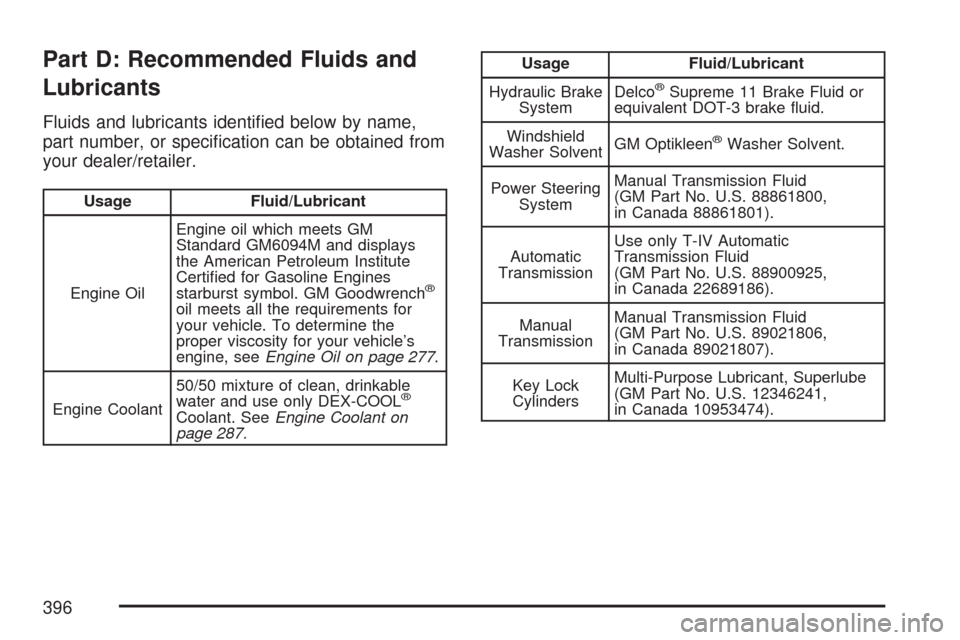
Part D: Recommended Fluids and
Lubricants
Fluids and lubricants identified below by name,
part number, or specification can be obtained from
your dealer/retailer.
Usage Fluid/Lubricant
Engine OilEngine oil which meets GM
Standard GM6094M and displays
the American Petroleum Institute
Certified for Gasoline Engines
starburst symbol. GM Goodwrench
®
oil meets all the requirements for
your vehicle. To determine the
proper viscosity for your vehicle’s
engine, seeEngine Oil on page 277.
Engine Coolant50/50 mixture of clean, drinkable
water and use only DEX-COOL
®
Coolant. SeeEngine Coolant on
page 287.
Usage Fluid/Lubricant
Hydraulic Brake
SystemDelco
®Supreme 11 Brake Fluid or
equivalent DOT-3 brake fluid.
Windshield
Washer SolventGM Optikleen
®Washer Solvent.
Power Steering
SystemManual Transmission Fluid
(GM Part No. U.S. 88861800,
in Canada 88861801).
Automatic
TransmissionUse only T-IV Automatic
Transmission Fluid
(GM Part No. U.S. 88900925,
in Canada 22689186).
Manual
TransmissionManual Transmission Fluid
(GM Part No. U.S. 89021806,
in Canada 89021807).
Key Lock
CylindersMulti-Purpose Lubricant, Superlube
(GM Part No. U.S. 12346241,
in Canada 10953474).
396
Page 413 of 436
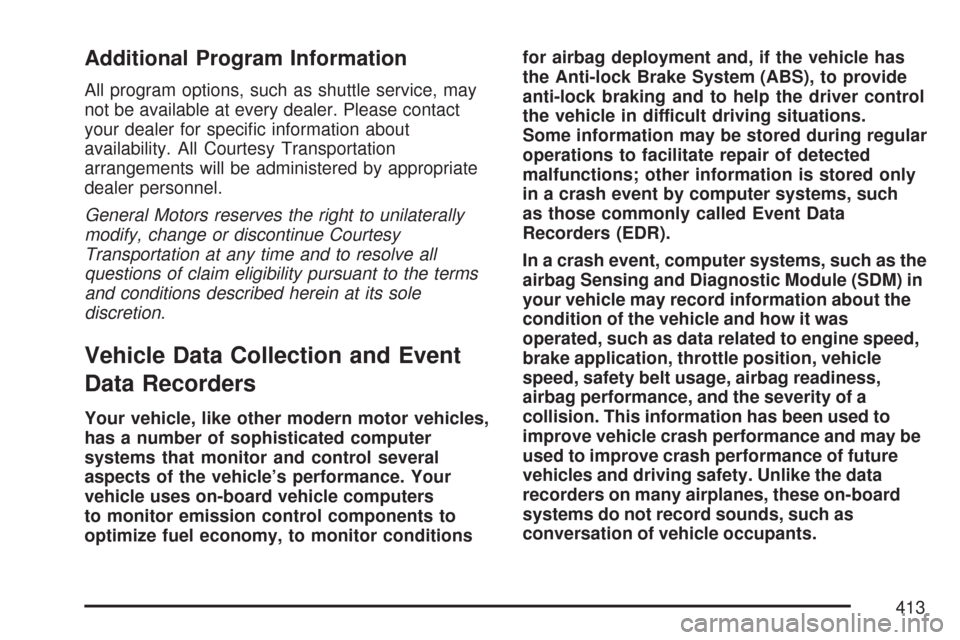
Additional Program Information
All program options, such as shuttle service, may
not be available at every dealer. Please contact
your dealer for specific information about
availability. All Courtesy Transportation
arrangements will be administered by appropriate
dealer personnel.
General Motors reserves the right to unilaterally
modify, change or discontinue Courtesy
Transportation at any time and to resolve all
questions of claim eligibility pursuant to the terms
and conditions described herein at its sole
discretion.
Vehicle Data Collection and Event
Data Recorders
Your vehicle, like other modern motor vehicles,
has a number of sophisticated computer
systems that monitor and control several
aspects of the vehicle’s performance. Your
vehicle uses on-board vehicle computers
to monitor emission control components to
optimize fuel economy, to monitor conditionsfor airbag deployment and, if the vehicle has
the Anti-lock Brake System (ABS), to provide
anti-lock braking and to help the driver control
the vehicle in difficult driving situations.
Some information may be stored during regular
operations to facilitate repair of detected
malfunctions; other information is stored only
in a crash event by computer systems, such
as those commonly called Event Data
Recorders (EDR).
In a crash event, computer systems, such as the
airbag Sensing and Diagnostic Module (SDM) in
your vehicle may record information about the
condition of the vehicle and how it was
operated, such as data related to engine speed,
brake application, throttle position, vehicle
speed, safety belt usage, airbag readiness,
airbag performance, and the severity of a
collision. This information has been used to
improve vehicle crash performance and may be
used to improve crash performance of future
vehicles and driving safety. Unlike the data
recorders on many airplanes, these on-board
systems do not record sounds, such as
conversation of vehicle occupants.
413
Page 420 of 436

In Canada, please call us at 1-800-263-3777
(English) or 1-800-263-7854 (French). Or, write:
General Motors of Canada Limited
Customer Communication Centre, CA1-163-005
1908 Colonel Sam Drive
Oshawa, Ontario L1H 8P7
Service Publications Ordering
Information
Service Manuals
Service Manuals have the diagnosis and repair
information on engines, transmission, axle
suspension, brakes, electrical, steering, body, etc.
Transmission, Transaxle, Transfer
Case Unit Repair Manual
This manual provides information on unit repair
service procedures, adjustments, and
specifications for GM transmissions, transaxles,
and transfer cases.
Service Bulletins
Service Bulletins give technical service information
needed to knowledgeably service General
Motors cars and trucks. Each bulletin contains
instructions to assist in the diagnosis and service
of your vehicle.
In Canada, the service bulletin reference number
can be obtained by contacting your General
Motors dealer or by calling 1-800-GM-DRIVE
(1-800-463-7483). This reference number is
needed to order the service bulletin from
Helm, Inc.
RETAIL SELL PRICE: $6.00 US + Processing Fee
420
Page 423 of 436
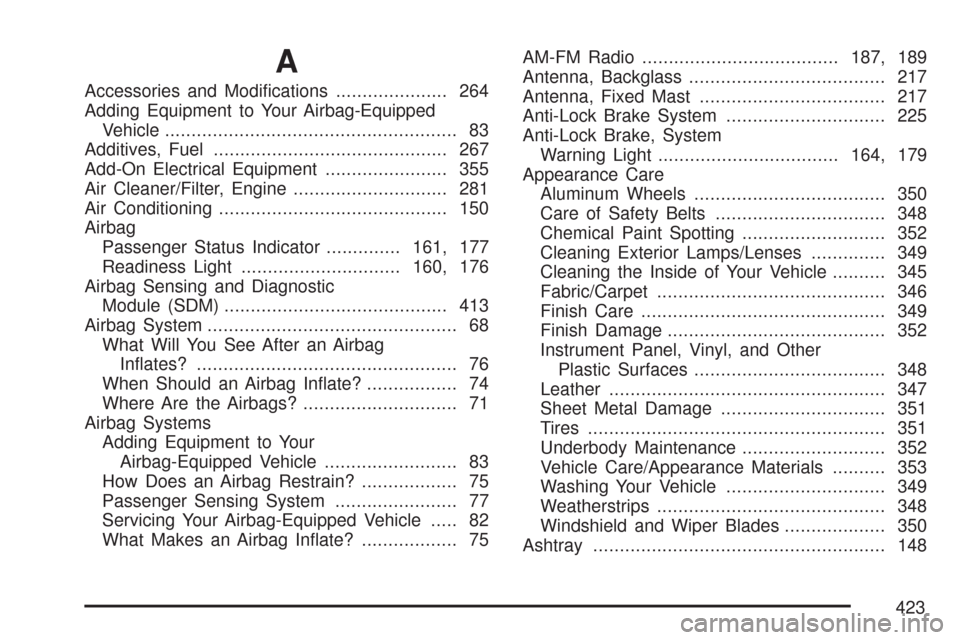
A
Accessories and Modifications..................... 264
Adding Equipment to Your Airbag-Equipped
Vehicle....................................................... 83
Additives, Fuel............................................ 267
Add-On Electrical Equipment....................... 355
Air Cleaner/Filter, Engine............................. 281
Air Conditioning........................................... 150
Airbag
Passenger Status Indicator..............161, 177
Readiness Light..............................160, 176
Airbag Sensing and Diagnostic
Module (SDM).......................................... 413
Airbag System............................................... 68
What Will You See After an Airbag
Inflates?................................................. 76
When Should an Airbag Inflate?................. 74
Where Are the Airbags?............................. 71
Airbag Systems
Adding Equipment to Your
Airbag-Equipped Vehicle......................... 83
How Does an Airbag Restrain?.................. 75
Passenger Sensing System....................... 77
Servicing Your Airbag-Equipped Vehicle..... 82
What Makes an Airbag Inflate?.................. 75AM-FM Radio.....................................187, 189
Antenna, Backglass..................................... 217
Antenna, Fixed Mast................................... 217
Anti-Lock Brake System.............................. 225
Anti-Lock Brake, System
Warning Light..................................164, 179
Appearance Care
Aluminum Wheels.................................... 350
Care of Safety Belts................................ 348
Chemical Paint Spotting........................... 352
Cleaning Exterior Lamps/Lenses.............. 349
Cleaning the Inside of Your Vehicle.......... 345
Fabric/Carpet........................................... 346
Finish Care.............................................. 349
Finish Damage......................................... 352
Instrument Panel, Vinyl, and Other
Plastic Surfaces.................................... 348
Leather.................................................... 347
Sheet Metal Damage............................... 351
Tires........................................................ 351
Underbody Maintenance........................... 352
Vehicle Care/Appearance Materials.......... 353
Washing Your Vehicle.............................. 349
Weatherstrips........................................... 348
Windshield and Wiper Blades................... 350
Ashtray....................................................... 148
423
Page 424 of 436
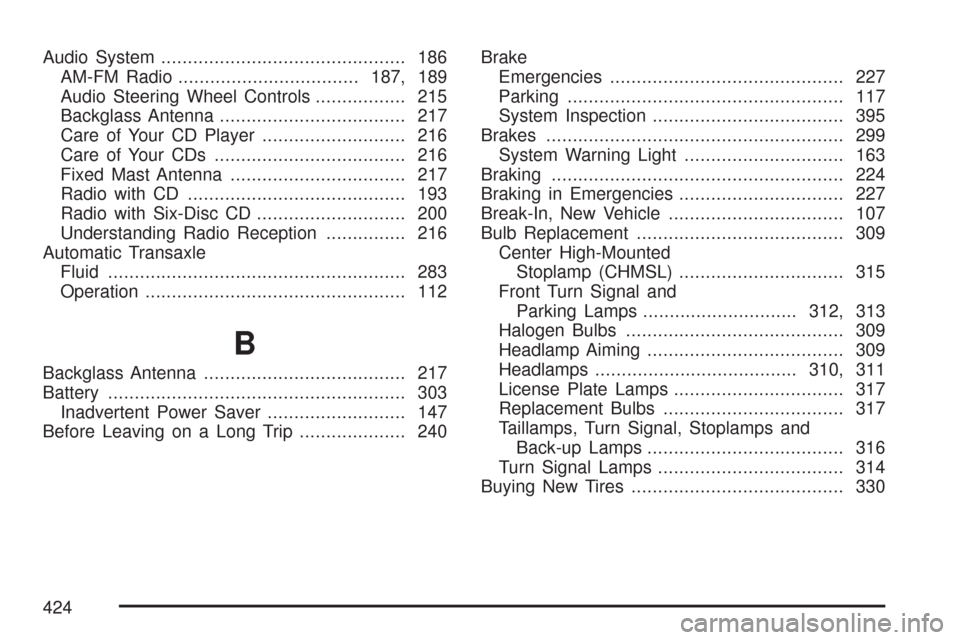
Audio System.............................................. 186
AM-FM Radio..................................187, 189
Audio Steering Wheel Controls................. 215
Backglass Antenna................................... 217
Care of Your CD Player........................... 216
Care of Your CDs.................................... 216
Fixed Mast Antenna................................. 217
Radio with CD......................................... 193
Radio with Six-Disc CD............................ 200
Understanding Radio Reception............... 216
Automatic Transaxle
Fluid........................................................ 283
Operation................................................. 112
B
Backglass Antenna...................................... 217
Battery........................................................ 303
Inadvertent Power Saver.......................... 147
Before Leaving on a Long Trip.................... 240Brake
Emergencies............................................ 227
Parking.................................................... 117
System Inspection.................................... 395
Brakes........................................................ 299
System Warning Light.............................. 163
Braking....................................................... 224
Braking in Emergencies............................... 227
Break-In, New Vehicle................................. 107
Bulb Replacement....................................... 309
Center High-Mounted
Stoplamp (CHMSL)............................... 315
Front Turn Signal and
Parking Lamps.............................312, 313
Halogen Bulbs......................................... 309
Headlamp Aiming..................................... 309
Headlamps......................................310, 311
License Plate Lamps................................ 317
Replacement Bulbs.................................. 317
Taillamps, Turn Signal, Stoplamps and
Back-up Lamps..................................... 316
Turn Signal Lamps................................... 314
Buying New Tires........................................ 330
424